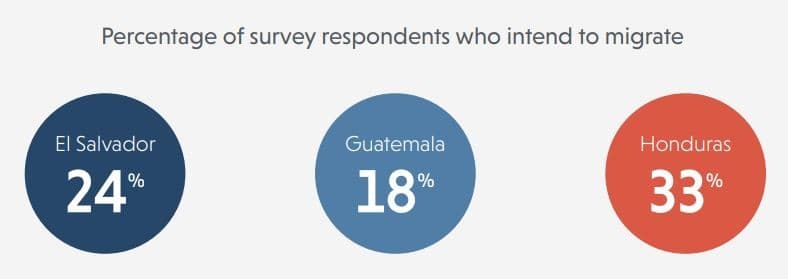The data on what drives Central American migration in 5 quick facts
By Jillian SlutzkerSeptember 9, 2019
What’s causing people from the Northern Triangle of Central America to take the risky journey to the United States and elsewhere?
Based on extensive data mining and 2,400 in-person interviews, Creative’s newly released study, “Saliendo Adelante: Why migrants risk it all,” provides nuanced insight into the localized factors that influence one’s decision to migrate. It focuses on the 60 municipalities across El Salvador, Honduras and Guatemala that account for more than half of the irregular migration from the region.
The study’s name, “Saliendo Adelante,” inspired by a Spanish phrase that connotes a feeling of resilience and a desire to move forward in life, was a sentiment echoed by many of the 2,400 individuals interviewed as part of this research.
With this local-level data, development programming can more effectively address the specific determinants that shape a person’s decision to make the risky, even dangerous, journey north.
Get five quick facts from the study below! To learn more, visit https://www.saliendo-adelante.com/.
1. Who intends to migrate?
At the national level, Creative’s study revealed that 33 percent of Hondurans intend to migrate, while 24 percent of Salvadorans intend to, followed by 18 percent of Guatemalans. The majority of these migrants are coming from just 60 municipalities in the Northern Triangle.

2. Economics is the primary driver
Overall, economic concerns are by far the most significant driving factor for migrants from the Northern Triangle. The study showed that economic concerns—including unemployment, household earnings under $400 per month and being unable to make ends meet, and a pessimistic economic outlook—are the primary statistically significant determinants for 71 percent of Guatemalans who intend to migrate, 67 percent of Hondurans who intend to and 50 percent of Salvadorans who do.
Those whose households earn less than $400 a month and who cannot make ends meet are 1.25 times more likely to consider migrating. More than one-third of survey respondents reported household earnings under the $400 line and said they could not make ends meet.
3. Being victimized makes you 1.5 more likely to migrate
Regionally, having been a victim of a crime or having a family member or someone else close to you who has been makes an individual 1.5 times more likely to consider migrating.
1 in 3 Hondurans who intend to migrate has had a family member or a close friend murdered.
Nearly one-third of survey respondents who have considered migrating from Honduras have had a family member or close friend murdered. Youth tend to be affected even more by victimization in their decision to migrate. In El Salvador, 1 in 4 young women aged 18 to 29 who intends to migrate has seen a family member or close friend murdered. In Honduras, 65 percent of young men who intend to migrate have been robbed on the street.
4. More than 1/3 of youth in the Northern Triangle plan to migrate
Across the three countries, on average 36.7 percent of youth intends to migrate.
In fact, respondents 18 to 29 years old are more than twice as likely to consider migrating than adults aged 30 and older. The data from Honduras is particularly stark: 46 percent of youth from the municipalities surveyed intend to migrate, compared to 28 percent of older adults.
Youth are exposed to factors at different rates from adults, and in some cases, react differently to those factors. According to the survey, Honduran young women intend to migrate more than young men. This is not the case in the other countries where young men were found to have higher intentions to migrate.

5. Reuniting with relatives not a large pull
Transnational ties – defined here as existence of family in the U.S., receipt of remittances, and prior migration to the U.S. – is a pull factor in the migration equation, but it is far less impactful than economics and victimization. Only 3 percent of survey respondents cited reuniting with relatives as their primary reason for wanting to migrate.
However, in the larger regional context, a culture of migration has been and continues to be solidified through the generations. Nearly two-thirds of all survey respondents have a relative living abroad, with 75 percent of those relatives have lived in the U.S. for 10 years or more.
Yet statistical analysis shows that simply having a family member in the U.S. is not a differentiating factor between those who intend to migrate and those who don’t, despite the large number of people who reported family ties.
To read more about the study, explore the data and hear migrants’ stories, visit: https://www.saliendo-adelante.com/

